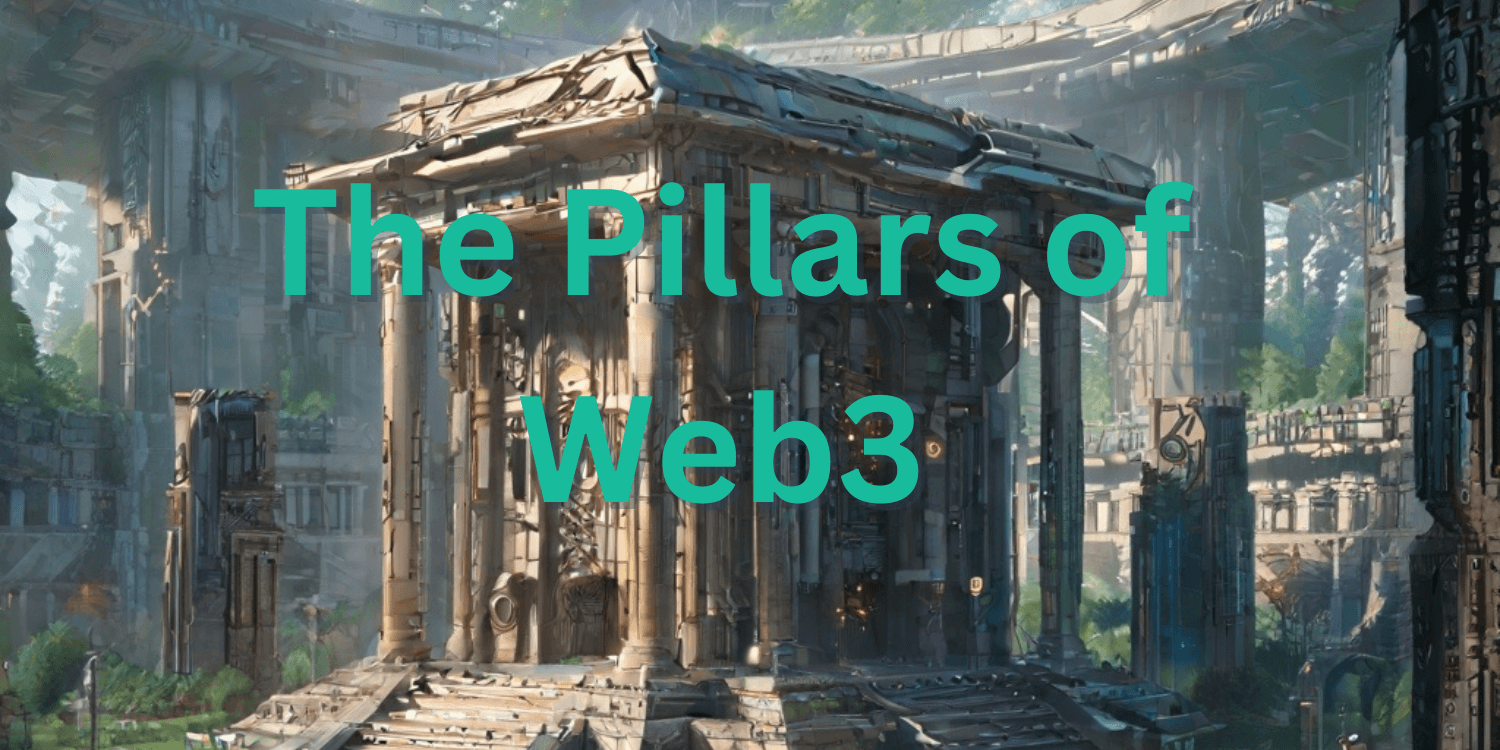
The Core Pillars of Web3
May 10, 2024
Paul Simroth
In this article you will find out what pillars Web3 consist of. You will find out what they mean and why they are there.
- Web3 Basics
The Core Principles of Web3
Web3 and Crypto are often misunderstood to be the same. In this article I will go over where they overlap and what Web3 really means. Contrary to popular belief, this technological paradigm shift transcends the areas of blockchain and consists of a diverse array of interconnected pillars, each having profound influence over the decentralized landscape. Web3 mainly consists of these core pillars:
1. Blockchain - The Pillar of Immutable Trust:
At the core of Web3 lies blockchain technology. Its cryptographic architecture promises transparency and incorruptibility, fundamentally reshaping how data is stored and transacted within digital landscapes. Blockchain serves as the bedrock upon which Web3 is constructed. It is used for providing the possibilities of trustless transactions and functions as the decentralized storage of “truth”.
2. Smart Contracts – What makes it all work:
A smart contract refers to a software program or transaction protocol designed to autonomously execute, manage, or record events and activities in accordance with predefined contract terms. The primary goals of smart contracts include diminishing reliance on trusted intermediaries, lowering arbitration expenses, and mitigating fraud risks, alongside minimizing both intentional and unintentional deviations from established rules. These contracts are frequently linked with cryptocurrencies, with Ethereum's smart contracts being widely recognized as a cornerstone for decentralized finance (DeFi), Crypto and Non-Fungible Token (NFT) applications. Smart Contracts are the prerequisite for Web3 to be possible.
3. Self-Custodial Wallets – The key to Digital Sovereignty:
Self-custodial wallets represent a paradigm shift in digital asset management, granting users autonomous control over their holdings without reliance on intermediaries like banks or exchanges. Within cryptocurrency networks, assets are managed via private cryptographic keys securely stored in wallets such as MetaMask, thereby ensuring decentralized governance. This transition towards self-custody not only enhances digital ownership but also underscores the imperative for users to adopt stringent security measures to protect their keys and safeguard their assets against potential risks and threats.
4. Cryptocurrency - The Currency of Decentralization:
Crypto is probably the most known pillar of Web3. Crypto Tokens (on ETH) are Smart Contracts following the ERC-20 Standard, which are meant as a digital store of value. These digital assets transcend geographical boundaries, making it possible for individuals to participate in decentralized and autonomous financial markets. Crypto is often rightfully criticized for pump-and-dumps (schemes where people, often influencers, tell you to invest in coins without a good use case where they hold a large amount and sell it as soon as their followers pump the price into drastic over-evaluation). While the critics are right on this part, it does not negate the projects where the token has a legitimate use case.
5. DApps – The Decentralized Web:
Decentralized applications (DApps) are crucial for Web3. A decentralized application (DApp) operates independently, typically utilizing smart contracts on decentralized computing platforms like blockchain or distributed ledger systems. Like traditional applications, DApps offer functionalities to users, but unlike their counterparts, they function autonomously without human intervention and without centralized ownership by a single entity. Instead, DApps distribute tokens representing ownership, which are allocated to users according to programmed algorithms, thereby decentralizing control. This lack of central control characterizes the decentralized nature of these applications. Projects like Ethereum or Cardano have popularized DApps, serving as foundational platforms for their development. DApps span various categories including exchanges, businesses, gambling, games, finance, development, storage, wallet, governance, property, identity, media, social, security, energy, insurance, and health, among others. Before DApps where a thing, interacting with a blockchain was rather difficult. Today all you need is a wallet, and you can connect yourself to a DApp and start using it. For this reason, they are crucial to enabling Web3 and are becoming more and more user friendly and provide more and more utility.
6. Oracles - Bridging between Worlds:
Blockchains have one major flaw. They exist in a sort of vacuum, where outside data does not get onto the chain. This is obviously a huge downside if you want to get data from, let´s say financial markets or if you want to track real world events. This is where Oracles come into play. An oracle network acts as a crucial link between blockchain platforms and real-world data sources, enabling the seamless integration of off-chain information into smart contracts. These networks, exemplified by solutions like Chainlink, facilitate the execution of hybrid smart contracts, enhancing the functionality of decentralized applications (DApps) by allowing them to react to external events and interact with traditional systems. While centralized oracle solutions present risks such as single points of failure and data manipulation, decentralized oracle mechanisms mitigate these concerns by distributing data verification tasks across a network of independent nodes. Ultimately, oracle networks play a vital role in expanding the utility and security of blockchain-based applications across various industries.
7. Decentralized Autonomous Organizations - DAOs:
Another pillar of Web3 is the decentralized Organization which happens in the from of DAOs. These are basically smart contracts where users can vote based on the parameters set by the protocol. This could be either depending on the amounts of tokens owned or one vote per wallet. DAOs represent an interesting concept on how the organization of Web3 can work without having no from of governance at all.
8. NFTs - Redefining Digital Ownership and Identity:
Non-Fungible Tokens (NFTs) are another big paradigm shift in the realm of digital ownership and identity. By tokenizing unique assets and intellectual properties, NFTs promise indisputable ownership and provenance, revolutionizing digital collectibles and beyond. While NFTs are widely known as there has been a big hype about them in the past, they can be more than simple pictures where you own a Token saying it is yours. NFTs are smart contracts which have a unique ID. This is what makes them rare. You can also pass metadata to the Token, which in the most known use cases is an image URL. But while the image only serves to represent a visual message, the token itself can be coded in many ways to make it serve many different use cases. Think like membership cards, collectibles or even a domain (which you can do with projects like Ethereum Name Service). Like Crypto, this aspect of Web3 has been widely criticized. The main issue seems to be lack of understanding what the NFT actually is. But after reading this article you now know what it really means.
In conclusion, while Web3 holds immense promise for decentralization and transparency for the internet, it's clear that we're just scratching the surface. With ongoing efforts and innovation, we can make Web3 more accessible and user-friendly, ensuring the evolution of how we interact online. If you're eager to dive into the world of Web3, joining forums and engaging with the community is the optimal path to embark on this transformative journey. Go out there and learn!
